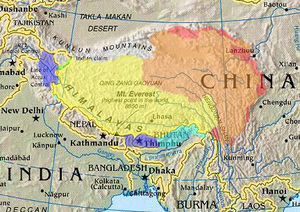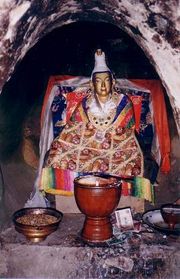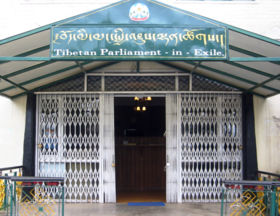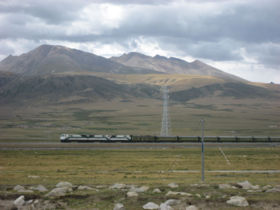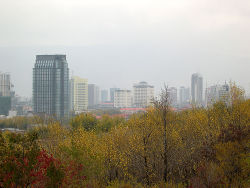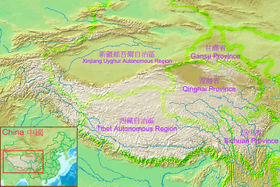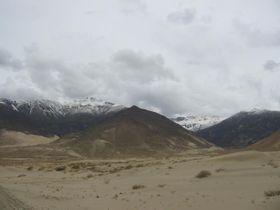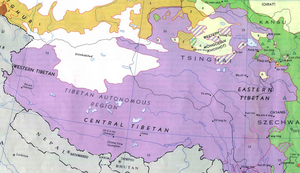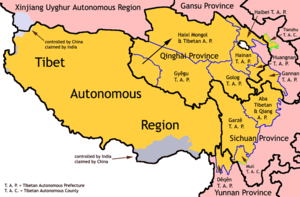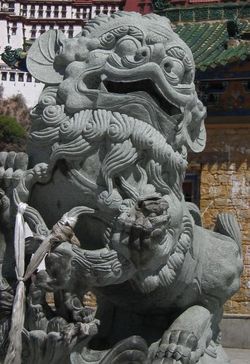Tibet
2007 Schools Wikipedia Selection. Related subjects: Asian Countries; Countries
| Claimed by Tibetan exile groups. | |||||||||
| Tibetan areas designated by PRC. | |||||||||
| Tibet Autonomous Region (actual control). | |||||||||
| Claimed by India as part of Aksai Chin. | |||||||||
| Claimed (not controlled) by the PRC as part of TAR. | |||||||||
| Other historically/culturally-Tibetan areas. | |||||||||
Tibet (older spelling Thibet; Tibetan: བོད་; Wylie: Bod; pronounced [pʰø̀ʔ] in the Lhasa dialect; Chinese: 西藏; pinyin: Xīzàng or Simplified Chinese: 藏区; Traditional Chinese: 藏區; pinyin: Zàngqū [the two names are used with different connotations; see Name section below]) is a region in Central Asia and the home of the Tibetan people. With an average elevation of 4,900 m (16,000 ft), it is often called the "Roof of the World".
Definitions
When the Government of Tibet in Exile and the Tibetan refugee community worldwide refer to Tibet, they mean a large area that formed the cultural entity of Tibet for many centuries, consisting of the traditional provinces of Amdo, Kham (Khams), and Ü-Tsang (Dbus-gtsang), but excluding areas outside the People's Republic of China (PRC) like Arunachal Pradesh (or South Tibet), Sikkim, Bhutan, and Ladakh that have also formed part of the Tibetan cultural sphere.
When the People's Republic of China refers to Tibet, it means the Tibet Autonomous Region (TAR): a province-level entity which, according to the territorial claims of the PRC, includes Arunachal Pradesh (presently under the administration of India). India considers Arunachal Pradesh as its integral part. Sikkim, Bhutan, and Ladakh may also be considered to be parts of cultural Greater Tibet in addition to Amdo, Kham, and Ü-Tsang. The TAR covers the Dalai Lama's former domain consisting of Ü-Tsang and western Kham, while Amdo and eastern Kham are now found within the provinces of Qinghai, Gansu, Yunnan, and Sichuan.
The difference in definition is a major sticking point in the dispute. The distribution of Amdo and eastern Kham into surrounding provinces was initiated by the Yongzheng Emperor during the eighteenth century and has been continuously maintained by successive Chinese governments. Tibetan exiles, in turn, consider the maintenance of this arrangement since the eighteenth century as part of a divide-and-rule policy.
A sovereign nation?
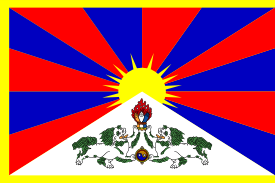
Tibet was once an independent empire, and is today administered mostly under the People's Republic of China. Tibet is also officially claimed by the Republic of China (Taiwan). The Chinese government and the Government of Tibet in Exile, however, disagree over when Tibet became a part of China, and whether this incorporation into China was legitimate.
Name
In Tibetan
Tibetans call their homeland Bod (བོད་), pronounced pö in Lhasa dialect. It is first attested in the geography of Ptolemy as βαται (batai) (Beckwith, C. U. of Indiana Diss. 1977). They refer to a fatherland (pha yul), while the Chinese use a gender-neutral term.
In Chinese
The modern Chinese name for Tibet, 西藏 (Xīzàng), is a phonetic transliteration derived from the region called Tsang (western Ü-Tsang). The name originated during the Qing Dynasty of China, ca. 1700. It can be broken down into "xi" 西 (literally "west"), and "zang" 藏 (literally "Buddhist scripture" or "storage"). The term can be interpreted as either "Buddhist scripture of the west" or "western storage." The pre-1700s historic Chinese term for Tibet was 吐蕃 (Tufan, Medieval Chinese pronuncation: /t'obwǝn/), which comes from the Turkish word for "heights" and is also the origin of the English term "Tibet."
The government of the People's Republic of China equates Tibet with the Tibet Autonomous Region (TAR). As such, the name "Xizang" is equated with the TAR. In order to refer non-TAR Tibetan areas, or to all of cultural Tibet, the term 藏区 Zàngqū (literally, "ethnic Tibetan areas") is used. However, Chinese-language versions of pro-Tibetan independence websites, such as the Free Tibet Campaign, the Voice of Tibet, and Tibet Net use 西藏 ("Xizang"), not 藏区 ("Zangqu"), to mean historic Tibet.
Some English-speakers reserve "Xizang", the Chinese word transliterated into English, for the TAR, to keep the concept distinct from that of historic Tibet. Some pro-independence advocates duplicate the situation into the Chinese language, and use 土番 (Tufan) or 图伯特 (Tubote), which are both phonetic transcriptions of the word "Tibet", to refer to historic Tibet, this is still used for research area and is known and accepted by most of the Chinese.
The character 藏 (zàng) has been used in transcriptions referring to Tsang as early as the Yuan Dynasty, if not earlier, though the modern term "Xizang" was devised in the 18th century. The Chinese character 藏 (Zàng) has also been generalized to refer to all of Tibet, including other concepts related to Tibet such as the Tibetan language (藏文, Zàngwén) and the Tibetan people (藏族, Zàngzú). The two characters of Xīzàng can literally mean "western storage", which some Tibetans find offensive and indicative of what they see as Chinese colonial attitudes towards Tibet. However, the offending character, "zàng", also literally means "sacred treasure" or "Buddhist scripture." In addition, Chinese transliterations of non-Chinese names do not necessarily take into account the literal meanings of words; usually a positive or neutral connotation combined with phonetic similarity is enough for the transliteration to come into use. See Transliteration into Chinese characters for other examples.
In English
The English word Tibet, like the word for Tibet in most European languages, is derived from the Arabic word Tubbat. Ultimately, the word derives via Persian from the Turkic word Töbäd (plural of Töbän), meaning "the heights". The same Turkic word is the origin of the Chinese term 吐蕃 (Pinyin tǔfān, but in Medieval times pronounced t'o-bwǝn ).
Cities
Lhasa is Tibet's traditional capital and the capital of Tibet Autonomous Region. Other cities in Historic Tibet include, in the TAR, Shigatse (Gzhis-ka-rtse), Gyantse (Rgyal-rtse), Chamdo (Chab-mdo), Nagchu, Nyingchi (Nying-khri), Nedong (Sne-gdong), Barkam ('Bar-khams), Sakya (Sa-skya), Gartse (Dkar-mdzes), Pelbar (Dpal-'bar), and Tingri (Ding-ri); in Sichuan, Dartsendo (Dar-btsen-mdo); in Qinghai, Kyegundo (Skye-rgu-mdo) or Yushu (Yul-shul), Machen (Rma-chen), Lhatse (Lhar-tse), and Golmud (Na-gor-mo). There is also a large Tibetian settlement in South India near Kushalnagara. India created this settlement for Tibetian refugees that escaped Chinese persecution and fled to India.
History
Early days
The Tibetan language is generally considered to be a Tibeto-Burman language of the Sino-Tibetan language family, distantly related to Chinese (Sinitic languages).
In general, the history of Tibet begins with King Srong-tsan-gam-po Songtsen Gampo (604–650 CE), although there were 27 kings before him. King Songtsen Gampo is generally considered to have introduced Buddhism to Tibet at this time. Christianity is known to have been present in Tibetan regions prior to 782.
King Songtsen Gampo sought to marry Princess Wen-Cheng, a member of the extended royal family of the Chinese Tang Dynasty.
Conflict between Tibet and the Tang began as Tu-Yu Huen was against the marriage. Tibet sent an army to drive it from the valleys around the source of Huang He. After the Tang general Hou Jun Ji drove the Tibetans out of Song Zhou, the Tang government became receptive and marriage took place in 641.
The next Tang emperor sent General Hsueh Zen-Kuei with an army to recover Tu-Yu Huen for the southern part of Qinghai (Amdo in Tibetan). A Tibetan army defeated him on the high plateau of Qinghai. Subsequently, Tibet conquered all small tribes in Qinghai and southern Xinjiang.
During this period, Tibet had a population of 10 million with 3 million Tibetans and an army of comparable strength facing the two Tang armies of Southern Xinjiang (24,000 soldiers) and of the Silk Road (75,000 soldiers). Disputes involved trade controls. Tibet wanted the four Tang garrisons at the Southern Xinjiang (which guarded the silk-road from central Tang through Xinjiang and Central Asia). After the Tang's withdrawal of the Silk-road army and its garrison troops of Northern and Southern Xinjiang during the An Lu-san rebellion, Tubo (Tibetan) military power conquered all of that territory up to the border of the Hue-He (Mongols), capturing the Silk-road.
Tibet had also conquered the ethnic tribes scattered in the present areas of Lijiang and Dali, Yunnan, and had established a military administration in northwest Yunnan. Yunnan was a tributary of Tibet. Tibet also bordered with India, and Persia. This was the largest area which was ever controlled by Tibet.
The military route used by the Tibetans to reach Yunnan was closely related to the contemporary tea and horse route. “Tea and Horse Caravan Road” of Southwest China is less well known than the famous Silk Road.
According to the Tibetan book Historic Collection of the Han and Tibet (Han Zang shi ji) “In the reign of the Tibetan King Chidusongzan [Khri ‘Dus sron] (676-704), the Tibetan aristocracy started to drink tea and use the tea-bowl, and tea was classified into different categories.”
After the downfall of the Tibetan Dynasty, the Tang recovered the Silk-road (848). According to one study, more than 20,000 warhorses per year were exchanged for tea during the Northern Song (960-1127) dynasty.
The distinctive form of Tibetan society, in which land was divided into three different types of holding—estates of noble families, freeheld lands and estates held by monasteries of particular Tibetan Buddhist sects—arose after the weakening of the Tibetan kings in the 10th century. This form of society was to continue into the 1950s, although Tibetan themselves claim that this is not an accurate description and that Tibetans consist of many different background and not just monks, masters, and serfs.
Mongols & Manchus
In 1240, the Mongols marched into central Tibet and attacked several monasteries. Köden, younger brother of Mongol ruler Güyük Khan, participated in a ceremony recognizing the Sa-skya lama as temporal ruler of Tibet in 1247. The Mongol khans had ruled northern China since 1215. They were the emperors of the Yuan Dynasty. Kublai Khan was a patron of Tibetan Buddhism and appointed the Sa-skya Lama his "Imperial preceptor," or chief religious official. Tibetans viewed this relationship as an example of yon-mchod, or priest-patron relationship. In practice, the Sa-skya lama was subordinate to the Mongol khan. The collapse of the Yuan dynasty in 1368 led to the overthrow of the Sa-skya in Tibet. Tibet was then ruled by a succession of three secular dynasties. In the 16th century, Altan Khan of Tumet Mongolian tribe supported the Dalai Lama's religious lineage to be the dominant religion among Mongols and Tibetans.
Beginning in the early 18th century, the Qing government sent a resident commissioner ( amban) to Lhasa. Tibetan factions rebelled in 1750 and killed the ambasa. Then, a Qing army entered and defeated the rebels and installed an administration headed by the Dalai Lama. The number of soldiers in Tibet was kept at about 2000. The defensive duties were partly helped out by a local force which was reorganized by the resident commissioner, and the Tibetan government continued to manage day-to-day affairs as before.
British influence
Main article: British expedition to Tibet
In 1904 a British diplomatic mission, accompanied by a large military escort, forced its way through to Lhasa. The head of the diplomatic mission was Colonel Francis Younghusband. The principal motivation for the British mission was a fear, which proved to be unfounded, that Russia was extending its footprint into Tibet and possibly even giving military aid to the Tibetan government. But in his way to Lhasa, Younghusband killed 1300 tibetans in Gyam-Tse(as written in "The Great Game" of Peter Hopkirk), because the natives were in fear of what kind of unequal treaty the English would offer to the Tibetans. When the mission reached Lhasa, the Dalai Lama had already fled to Urga in Mongolia, but a treaty was signed by lay and ecclesiastical officials of the Tibetan government, and by representatives of the three monasteries of Sera, Drepung, and Ganden. The treaty made provisions for the frontier between Sikkim and Tibet to be respected, for freer trade between British and Tibetan subjects, and for an indemnity to be paid from the Tibetan Government to the British Government for its expenses in dispatching armed troops to Lhasa. It also made provision for a British trade agent to reside at the trade mart at Gyantse. The provisions of this 1904 treaty were confirmed in a 1906 treaty signed between Britain and China, in which the British also agreed "not to annex Tibetan territory or to interfere in the administration of Tibet.". The position of British Trade Agent at Gyantse was occupied from 1904 up until 1944. It was not until 1937, with the creation of the position of "Head of British Mission Lhasa", that a British officer had a permanent posting in Lhasa itself.
A Nepalese agency had also been established in Lhasa after the invasion of Tibet by the Gurkha government of Nepal in 1855.
In the Anglo-Chinese Convention of 1906 which confirmed the Anglo-Tibetan Treaty of 1904, Britain agreed "not to annex Tibetan territory or to interfere in the administration of Tibet" while China engaged "not to permit any other foreign State to interfere with the territory or internal administration of Tibet". In the Anglo-Russian Convention of 1907, Britain also recognized the "suzerainty of China over Thibet" and, in conformity with such admitted principle, engaged "not to enter into negotiations with Thibet except through the intermediary of the Chinese Government." Suzerainty is a situation in which a region or people is a tributary to a more powerful entity which allows the tributary some limited domestic autonomy but controls its foreign affairs. The Qing central government established direct rule over Tibet for the first time in 1910. The thirteenth Dalai Lama fled to British India in February 1910. In the same month, the Chinese Qing government issued a proclamation deposing the Dalai Lama and instigating the search for a new incarnation. While in India the Dalai Lama became a close friend of the British Political Officer Charles Bell. The official position of the British Government was that they would not intervene between China and Tibet, and it would only recognize the de facto government of China within Tibet at this time. In Bell's history of Tibet, he would write of this time that "the Tibetans were abandoned to Chinese aggression, an aggression for which the British Military Expedition to Lhasa and subsequent retreat [and consequent power vacuum within Tibet] were primarily responsible".
Relations with the Republic of China
In February of 1912 the Qing emperor abdicated and the new Republic of China was formed. In April of 1912 the Chinese garrison of troops in Lhasa surrendered to the Tibetan authorities. The new Chinese Republican government wished to make the commander of the Chinese troops in Lhasa their new Tibetan representative, but the Tibetans were in favour of having all of the Chinese troops return to China Proper. The Dalai Lama returned to Tibet from India in July 1912. By the end of 1912, the Chinese troops in Tibet had returned, via India, to China Proper. In 1913, Tibet and Mongolia signed a treaty proclaiming mutual recognition and their independence from China. In 1914, a treaty was negotiated in India by representatives of China, Tibet and Britain: the Simla Convention. During the convention, the British tried to divide Tibet into Inner and Outer Tibet. When negotiations broke down over the specific boundary between Inner and Outer, the British demanded instead to advance their line of control, enabling them to annex 90,000 square kilometers of traditional Tibetan territory in southern Tibet, which corresponds to most of the modern Indian state of Arunachal Pradesh, while recognizing Chinese suzerainty, but not sovereignty, over Tibet. Tibetan representatives secretly signed under British pressure; however, the representative of Chinese central government declared that the secretive annexation of territory was not acceptable. The boundary established in the convention, the McMahon Line, was considered by the British and later the independent Indian government to be the boundary; however, the Chinese view since then has been that since China, which was sovereign over Tibet, did not sign the treaty, the treaty was meaningless, and the annexation and control of southern Tibet Arunachal Pradesh by India is illegal. This paved the way to the Sino-Indian War of 1962 and the boundary dispute between China and India today.
The subsequent outbreak of World War I and civil war in China caused the Western powers and the infighting factions of China proper to lose interest in Tibet, and the 13th Dalai Lama ruled undisturbed. At that time, the government of Tibet controlled all of Ü-Tsang (Dbus-gtsang) and western Kham (Khams), roughly coincident with the borders of Tibet Autonomous Region today. Eastern Kham, separated by the Yangtze River was under the control of Chinese warlord Liu Wenhui. The situation in Amdo ( Qinghai) was more complicated, with the Xining area controlled by ethnic Hui warlord Ma Bufang, who constantly strove to exert control over the rest of Amdo (Qinghai).
Rule of the People's Republic of China
Neither the Republic of China nor the People's Republic of China has ever renounced China's claim to sovereignty over Tibet. In 1950, the People's Liberation Army entered the Tibetan area of Chamdo, crushing nominal resistance from the ill-equipped Tibetan army. In 1951, the Seventeen Point Agreement was forced upon by PLA's military, by representatives of the Dalai Lama and Beijing affirming Chinese sovereignty over Tibet with a joint administration under representatives of the central government and the Tibetan government. Most of the population of Tibet at that time were serfs ("mi ser"), often bound to land owned by monasteries and aristocrats, the Tibetans-in-exile claim that the Serfs and Masters were only small part of Tibet and that Tibetans are from vast different backgrounds such as nomads, merchants, farmers, traders, thieves, bandits, aristocrats, Tibetan doctors, teachers, monks, nuns, beggars, artists, singers, musicians, and many more, just like any other civilization. Argument has always made by Tibetans that Tibet would modernized by itself without the unnecessary intervention by China. Any attempt at land redistribution or the redistribution of wealth would have proved unpopular with the established landowners. This agreement was initially put into effect in Tibet proper. However, Eastern Kham and Amdo were outside the administration of the government of Tibet, and were thus treated like any other Chinese province with land redistribution implemented in full. As a result, a rebellion broke out in Amdo and eastern Kham in June of 1956. The insurrection, supported by the American CIA, eventually spread to Lhasa. It was crushed by 1959. Tibetan exiles claim that during this campaign, tens of thousands of Tibetans were killed. The 14th Dalai Lama and other government principals fled to exile in India, but isolated resistance continued in Tibet until 1969 when CIA support was withdrawn.
Although the Panchen Lama remained a virtual prisoner, the Chinese set him as a figurehead in Lhasa, claiming that he headed the legitimate Government of Tibet since Dalai Lama has fled to India because of the 1959 riots and established the traditional head of the Tibetan government. In 1965, the area that had been under the control of the Dalai Lama's government from the 1910s to 1959 (U-Tsang and western Kham) was set up as an Autonomous Region. The monastic estates were broken up and secular education introduced. During the Cultural Revolution, the Red Guards inflicted a campaign of organized vandalism against cultural sites in the entire PRC, including Tibet's Buddhist heritage. Many young Tibetans joined in the campaign of destruction, voluntarily due to the ideological fervour that was sweeping the entire PRC and involuntarily due to the fear of being denounced as "enemies of the people". Of the several thousand monasteries in Tibet, over 6000 were destroyed, only a handful remained without major damage, and thousands of Buddhist monks and nuns were killed or imprisoned.
In 1989, the Panchen Lama mysteriously died, just as his open condemnation of Chinese policies intensified. The Dalai Lama and the PRC recognised different reincarnations. While officially an atheist state, the People's Republic of China has affirmed its right to confirming high-level reincarnations, a tulku in the Tibetan tradition of Vajrayana Buddhism, citing a precedent set by the Qianlong Emperor of the Qing Dynasty (The PRC view is that Qianlong instituted a system of selecting the Panchen Lama, the Dalai Lama and other high lamas by means of a lottery which utilised a golden urn with names wrapped in barley balls; the view of Tibetan exiles is that the system was a suggestion made by Qianlong and was not a prerequisite for choosing the Panchen Lama). The Dalai Lama named Gedhun Choekyi Nyima as the 11th Panchen Lama but without confirmation by the vase lot, while the PRC named another child, Gyancain Norbu by the vase lot. Gyancain Norbu was raised in Beijing and has appeared occasionally on state media. Because of China's selection of the next potentially important lama, many Tibetan believe that China is systematically destroying the Tibetan identity and solidarity. Gedhun Choekyi Nyima and his family have gone missing, into imprisonment according to Tibetan exiles, and under a hidden identity for protection and privacy according to the PRC.

Since 1979, there have been major economic changes, like the rest of the PRC, but the political system remains undemocratic and repressive. Some PRC policies in Tibet have been described as moderate, while others are judged to be more oppressive. Most religious freedoms have been officially restored, provided the lamas do not challenge PRC rule. Foreigners can visit most parts of Tibet, and it is claimed that the less savoury aspects of PRC rule are kept hidden from visitors.
The PRC continues to portray its rule over Tibet as an unalloyed improvement, and foreign governments continue to make occasional protests about aspects of PRC rule in Tibet because of frequent report of human rights violation in Tibet by many Human rights group such as Human rights watch (hrw.org). All governments, however, recognize PRC sovereignty over Tibet, and none has recognized the Dalai Lama's government in exile in India.
Evaluation of PRC rule
Evaluation by the Tibetan exile community

Tibetan exiles state that the number that have died in the much unwanted Great Leap Forward, of violence, or other indirect causes since 1950 is approximately 1.2 million, which the Chinese Communist Party denies. According to Patrick French, the estimate is not reliable because the Tibetans were not able to process the data well enough to produce a credible total. There were, however, many casualties, perhaps as many as 400,000. This figure is extrapolated from a calculation Warren W. Smith made from census reports of Tibet which show 200,000 "missing" from Tibet. Even The Black Book of Communism expresses doubt at the 1.2 million figure, but does note that according to Chinese census the total population of ethnic Tibetans in the PRC was 2.8 million in 1953, but only 2.5 million in 1964. It puts forward a figure of 800,000 deaths and alleges that as many as 10% of Tibetans were interned, with few survivors. Chinese demographers have estimated that 90,000 of the 300,000 "missing" Tibetans fled the region.
The government of Tibet in Exile also says that, fundamentally, the issue is that of the right to self-determination of the Tibetan people. While refusing to agree to China's demands that he renounce the idea that Tibet was once an independent country, the Dalai Lama has stated his willingness to negotiate with China for "genuine autonomy" (over the objection of those Tibetans who push for full independence). The Dalai Lama sees the millions of Han immigrants, attracted to the TAR by economic incentives and preferential socioeconomic policies, as presenting an urgent threat to the Tibetan nation by diluting the Tibetans both culturally and through intermarriage. Exile groups say that despite recent attempts to restore the appearance of original Tibetan culture to attract tourism, the traditional Tibetan way of life is now irrevocably changed. Supporters of the Dalai Lama argue that comparisons between the theocracy before 1950 and the Tibet of today are false because, if China had not invaded, the Dalai Lama would have worked to improve the material lot of the people, their political rights, and in doing so has disturbed the natural process of a legitimate nation.
It is reported that when Hu Yaobang, the general secretary of the Chinese Communist Party, visited Lhasa in 1980 he was unhappy when he found out the region was behind neighbouring provinces. Policies were changed, and since then the central government's policy in Tibet has granted most religious freedoms. But monks and nuns are still sometimes imprisoned, and many Tibetans (mostly monks and nuns) continue to flee Tibet yearly. At the same time, many Tibetans view projects that the PRC claims to benefit Tibet, such as the China Western Development economic plan or the Qinghai-Tibet Railway, as politically-motivated actions to consolidate central control over Tibet by facilitating militarization and Han migration while benefiting few Tibetans; they also view the money funneled into cultural restoration projects as being aimed at attracting foreign tourists. They note that Tibet is still behind the rest of the PRC: for example, the first big hospital in Tibet was not built until 1985; that several of Lhasa's main roads weren't paved until 1987; and that the first students at Tibet University didn't graduate until 1988. They also say that there is still preferential treatment awarded to Han in the labor market as opposed to Tibetans.
Evaluation by the People's Republic of China
The government of the PRC says that the population of Tibet in 1737 was about 8 million, and that due to the backward rule of the local theocracy, there was rapid decrease in the next two hundred years and the population in 1959 was only about 1.19 million. Today, the population of Greater Tibet is 7.3 million, of which, according to the 2000 census, 6 million are ethnic Tibetans. The government of the PRC views this population growth as the result of the abolition of the theocracy and the introduction of a modern, higher standard of living. Based on the census numbers, the PRC also rejects claims that the Tibetans are being swamped by Han Chinese; instead the PRC says that the border for Greater Tibet drawn by the government of Tibet in Exile is so large that it incorporates regions such as Xining that were never traditionally Tibetan in the first place, hence exaggerating the number of non-Tibetans.
The government of the PRC also rejects claims that the lives of Tibetans have deteriorated, pointing to rights enjoyed by the Tibetan language in education and in courts and says that the lives of Tibetans have been improved immensely compared to the Dalai Lama's rule before 1950. Benefits that are commonly quoted include: the GDP of Tibet Autonomous Region (TAR) today is 30 times that before 1950; TAR has 22,500 km of highways, as opposed to 0 in 1950; all secular education in TAR was created after the revolution; TAR now has 25 scientific research institutes as opposed to 0 in 1950; infant mortality has dropped from 43% in 1950 to 0.661% in 2000; life expectancy has risen from 35.5 years in 1950 to 67 in 2000; the collection and publishing of the traditional Epic of King Gesar, which is the longest epic poem in the world and had only been handed down orally before; allocation of 300 million Renminbi since the 1980s to the maintenance and protection of Tibetan monasteries. The Cultural Revolution and the cultural damage it wrought upon the entire PRC is generally condemned as a nationwide catastrophe, whose main instigators (in the PRC's view, the Gang of Four) have been brought to justice and whose reoccurrence is unthinkable in an increasingly modernized China. The China Western Development plan is viewed by the PRC as a massive, benevolent, and patriotic undertaking by the wealthier eastern coast to help the western parts of China, including Tibet, catch up in prosperity and living standards.
Geography
Tibet is located on the Tibetan Plateau, the world's highest region. Most of the Himalaya mountain range, one of the youngest mountain ranges in the world at only 4 million years old, lies within Tibet. Its most famous peak, Mount Everest, is on Nepal's border with Tibet. The average altitude is about 3,000 m in the south and 4,500 feet in the north.
The atmosphere is severely dry nine months of the year, and average snowfall is only 18 inches, due to the rain shadow effect whereby mountain ranges prevent moisture from the ocean from reaching the plateaus. Western passes receive small amounts of fresh snow each year but remain traversable year round. Low temperatures are prevalent throughout these western regions, where bleak desolation is unrelieved by any vegetation beyond the size of low bushes, and where wind sweeps unchecked across vast expanses of arid plain. The Indian monsoon exerts some influence on eastern Tibet. Northern Tibet is subject to high temperatures in summer and intense cold in winter.
Historic Tibet consists of several regions:
- Amdo (A mdo) in the northeast, incorporated by China into the provinces of Qinghai, Gansu and Sichuan.
- Kham (Khams) in the east, divided between Sichuan, northern Yunnan and Qinghai.
- Western Kham, part of the Tibetan Autonomous Region
- U (dBus), in the centre, and Tsang (gTsang) in the centre-west, part of the Tibetan Autonomous Region
- Ngari (mNga' ris) in the far west, part of the Tibetan Autonomous Region
Tibetan cultural influences extend to the neighboring states of Bhutan, Nepal, adjacent regions of India such as Sikkim and Ladakh, and adjacent provinces of China where Tibetan Buddhism is the predominant religion.
On the border with India, the region popularly known among Chinese as South Tibet is claimed by China and administered by India as the state of Arunachal Pradesh.
Several major rivers have their source in the Tibetan Plateau (mostly in present-day Qinghai Province), including:
- Yangtze
- Yellow River
- Indus River
- Mekong
- Brahmaputra
- Ganges
- Salween
Economy
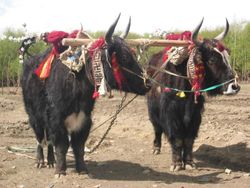
The Tibetan economy is dominated by subsistence agriculture. Due to limited arable land, livestock raising is the primary occupation. In recent years, due to the increased interest in Tibetan Buddhism tourism has become an increasingly important sector, and is actively promoted by the authorities.
The Qinghai-Tibet Railway which links the region to Qinghai in China proper was opened in 2006. The Chinese government claims that the line will promote the development of impoverished Tibet. But opponents argue the railway will harm Tibet. For instance, Tibetan opponents contend that it would only draw more Han Chinese residents, the country's dominant ethnic group, who have been migrating steadily to Tibet over the last decade, bringing with them their popular culture. They believe that the large influx of Han Chinese will ultimately extinguish the local culture. Other opponents argue that the railway will damage Tibet's fragile ecology and that most of its economic benefits will go to migrant Han Chinese. As activists call for a boycott of the railway, the Dalai Lama has urged Tibetans to "wait and see" what benefits the new line might bring to them. According to Government-in-exile's spokemen, the Dalai Lama welcomes the building of the railway, "conditioned on the fact that the railroad will bring benefit to the majority of Tibetans."
Demographics
Historically, the population of Tibet consisted of primarily ethnic Tibetans. Other ethnic groups in Tibet include Menba (Monpa), Lhoba, Mongols and Hui. According to tradition the original ancestors of the Tibetan people, as represented by the six red bands in the Tibetan flag, are: the Se, Mu, Dong, Tong, Dru and Ra.
The issue of the proportion of the Han Chinese population in Tibet is a politically sensitive one. The Tibetan Government-in-Exile says that the People's Republic of China has actively swamped Tibet with Han Chinese migrants in order to alter Tibet's demographic makeup, while the People's Republic of China has denied this.
View of the Tibetan exile community
Between the 1960s and 1980s, many prisoners (over 1 million, according to Harry Wu) were sent to laogai camps in Amdo ( Qinghai), where they were then employed locally after release. Since the 1980s, increasing economic liberalization and internal mobility has also resulted in the influx of many Han Chinese into Tibet for work or settlement, though the actual number of this floating population remains disputed. The Government of Tibet in Exile gives the number of non-Tibetans in Tibet as 7.5 million (as opposed to 6 million Tibetans), and considers this the result of an active policy of demographically swamping the Tibetan people and further diminishing any chances of Tibetan political independence, and as such, to be in violation of the Geneva Convention of 1946 that prohibits settlement by occupying powers. The Government of Tibet in Exile questions all statistics given by the PRC government, since they do not include members of the People's Liberation Army garrisoned in Tibet, or the large floating population of unregistered migrants. The Qinghai-Tibet Railway ( Xining to Lhasa) is also a major concern, as it is believed to further facilitate the influx of migrants.
View of the People's Republic of China
The PRC government does not view itself as an occupying power and has vehemently denied allegations of demographic swamping. The PRC also does not recognize Greater Tibet as claimed by the government of Tibet in Exile, saying that the idea was engineered by foreign imperialists as a plot to divide China amongst themselves, and that those areas outside the TAR were not controlled by the Tibetan government before 1959 in the first place, having been administered instead by other surrounding provinces for centuries. The PRC gives the number of Tibetans in Tibet Autonomous Region as 2.4 million, as opposed to 190,000 non-Tibetans, and the number of Tibetans in all Tibetan autonomous entities combined (slightly smaller than the Greater Tibet claimed by exiled Tibetans) as 5.0 million, as opposed to 2.3 million non-Tibetans. In the TAR itself, much of the Han population is to be found in Lhasa. Population control policies like the one-child policy only apply to Han Chinese, not to minorities such as Tibetans. Jampa Phuntsok, chairman of the TAR, has also said that the central government has no policy of migration into Tibet due to its harsh high-altitude conditions, that the 6% Han in the TAR is a very fluid group mainly doing business or working, and that there is no immigration problem.
| Major ethnic groups in Greater Tibet by region, 2000 census | |||||||
|---|---|---|---|---|---|---|---|
| Total | Tibetans | Han Chinese | others | ||||
| Tibet Autonomous Region: | 2,616,329 | 2,427,168 | 92.8% | 158,570 | 6.1% | 30,591 | 1.2% |
| - Lhasa PLC | 474,499 | 387,124 | 81.6% | 80,584 | 17.0% | 6,791 | 1.4% |
| - Chamdo Prefecture | 586,152 | 563,831 | 96.2% | 19,673 | 3.4% | 2,648 | 0.5% |
| - Lhokha Prefecture | 318,106 | 305,709 | 96.1% | 10,968 | 3.4% | 1,429 | 0.4% |
| - Shigatse Prefecture | 634,962 | 618,270 | 97.4% | 12,500 | 2.0% | 4,192 | 0.7% |
| - Nagchu Prefecture | 366,710 | 357,673 | 97.5% | 7,510 | 2.0% | 1,527 | 0.4% |
| - Ngari Prefecture | 77,253 | 73,111 | 94.6% | 3,543 | 4.6% | 599 | 0.8% |
| - Nyingtri Prefecture | 158,647 | 121,450 | 76.6% | 23,792 | 15.0% | 13,405 | 8.4% |
| Qinghai Province: | 4,822,963 | 1,086,592 | 22.5% | 2,606,050 | 54.0% | 1,130,321 | 23.4% |
| - Xining PLC | 1,849,713 | 96,091 | 5.2% | 1,375,013 | 74.3% | 378,609 | 20.5% |
| - Haidong Prefecture | 1,391,565 | 128,025 | 9.2% | 783,893 | 56.3% | 479,647 | 34.5% |
| - Haibei AP | 258,922 | 62,520 | 24.1% | 94,841 | 36.6% | 101,561 | 39.2% |
| - Huangnan AP | 214,642 | 142,360 | 66.3% | 16,194 | 7.5% | 56,088 | 26.1% |
| - Hainan AP | 375,426 | 235,663 | 62.8% | 105,337 | 28.1% | 34,426 | 9.2% |
| - Golog AP | 137,940 | 126,395 | 91.6% | 9,096 | 6.6% | 2,449 | 1.8% |
| - Gyêgu AP | 262,661 | 255,167 | 97.1% | 5,970 | 2.3% | 1,524 | 0.6% |
| - Haixi AP | 332,094 | 40,371 | 12.2% | 215,706 | 65.0% | 76,017 | 22.9% |
| Tibetan areas in Sichuan province | |||||||
| - Aba AP | 847,468 | 455,238 | 53.7% | 209,270 | 24.7% | 182,960 | 21.6% |
| - Garzê AP | 897,239 | 703,168 | 78.4% | 163,648 | 18.2% | 30,423 | 3.4% |
| - Muli AC | 124,462 | 60,679 | 48.8% | 27,199 | 21.9% | 36,584 | 29.4% |
| Tibetan areas in Yunnan province | |||||||
| - Dêqên AP | 353,518 | 117,099 | 33.1% | 57,928 | 16.4% | 178,491 | 50.5% |
| Tibetan areas in Gansu province | |||||||
| - Gannan AP | 640,106 | 329,278 | 51.4% | 267,260 | 41.8% | 43,568 | 6.8% |
| - Tianzhu AC | 221,347 | 66,125 | 29.9% | 139,190 | 62.9% | 16,032 | 7.2% |
| Total for Greater Tibet: | |||||||
| With Xining and Haidong | 10,523,432 | 5,245,347 | 49.8% | 3,629,115 | 34.5% | 1,648,970 | 15.7% |
| Without Xining and Haidong | 7,282,154 | 5,021,231 | 69.0% | 1,470,209 | 20.2% | 790,714 | 10.9% |
This table includes all Tibetan autonomous entities in the People's Republic of China, plus Xining PLC and Haidong P. The latter two are included to complete the figures for Qinghai province, and also because they are claimed as parts of Greater Tibet by the Government of Tibet in exile.
P = Prefecture; AP = Autonomous prefecture; PLC = Prefecture-level city; AC = Autonomous county
Excludes members of the People's Liberation Army in active service.
Source: Department of Population, Social, Science and Technology Statistics of the National Bureau of Statistics of China (国家统计局人口和社会科技统计司) and Department of Economic Development of the State Ethnic Affairs Commission of China (国家民族事务委员会经济发展司), eds. Tabulation on Nationalities of 2000 Population Census of China (《2000年人口普查中国民族人口资料》). 2 vols. Beijing: Nationalities Publishing House (民族出版社), 2003. ( ISBN 7-105-05425-5)
Culture
Tibet is the traditional centre of Tibetan Buddhism, a distinctive form of Vajrayana, which is also related to the Shingon Buddhist tradition in Japan. Tibetan Buddhism is practiced not only in Tibet but also in Mongolia, the Buryat Republic, the Tuva Republic, and in the Republic of Kalmykia. Tibet is also home to the original spiritual tradition called Bön (also spelled Bon). Various dialects of the Tibetan language are spoken across the country. Tibetan is written in Tibetan script.
In Tibetan cities, there are also small communities of Muslims, known as Kachee (Kache), who trace their origin to immigrants from three main regions: Kashmir (Kachee Yul in ancient Tibetan), Ladakh and the Central Asian Turkic countries. Islamic influence in Tibet also came from Persia. After the invasion of Tibet in 1959 a group of Tibetan Muslims made a case for Indian nationality based on their historic roots to Kashmir and the Indian government declared all Tibetan Muslims Indian citizens later on that year. There is also a well established Chinese Muslim community (gya kachee), which traces its ancestry back to the Hui ethnic group of China. It is said that Muslim migrants from Kashmir and Ladakh first entered Tibet around the 12th century. Marriages and social interaction gradually led to an increase in the population until a sizable community grew up around Lhasa.
The Potala Palace, former residence of the Dalai Lamas, is a World Heritage Site, as is Norbulingka, former summer residence of the Dalai Lama.
During the suppression of pro-independence forces in the 1950s, and during the Cultural Revolution in the 1960s, most historically significant sites in Tibet were vandalized or totally destroyed. Due to recent build up of some of the major monastery, Tibetans believe that this is attempt to portray false image of Tibet.
Since 2002, Tibetan's in exile have allowed a Miss Tibet beauty contest in spite of concerns that this event is considered a Western influence. The beauty contest is condemned by the Tibetan government in exile.
